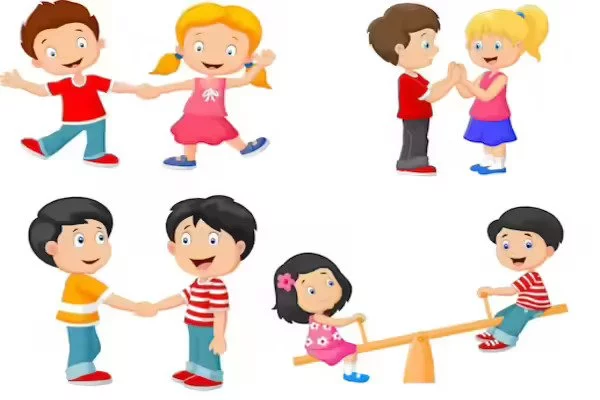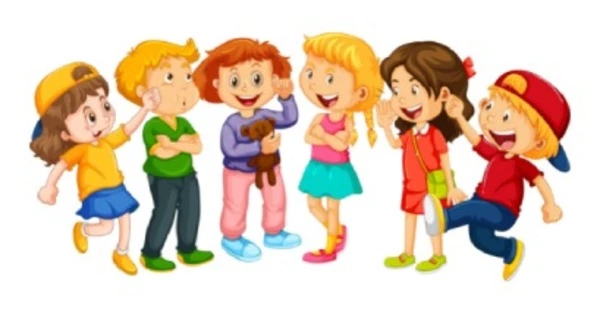Social interactions involve communication, cooperation, and the exchange of ideas and emotions. They play a key role in forming and maintaining relationships, building community, and shaping our cultural and societal norms. They are a crucial part of our development and shape our relationships with others.
Early in life, children demonstrate social skills and a strong desire to interact with their peers. According to a new study, they engage in social interactions more frequently than our closest relatives, the great apes. This social and natural human proclivity for interaction appears to be an important factor in understanding the evolution of language.
What do pyramids, going to the moon, paddling a two-person canoe, and waltzing all have in common? All of these actions are the result of multiple partners working together to achieve a common goal, which leads to a mutual sense of obligation, also known as “joint commitment.” This ability to cooperate is universal in humans and certain animal species, such as great apes.
There have been only a few quantitative analyses of the spontaneous social interactions of 2 and 4 year olds while interacting with peers, although it is a critical age for the development of children’s socio-cognitive abilities.
Federico Rossano
According to the study’s authors, humans appear to have a unique predisposition and strong desire for social interaction, which may be one of the components of the emergence of language. How are our social interactions different from those of other species? And why is this so? An international team examined the interactions of 31 children aged 2 to 4 in four preschools in the United States to find answers to these questions (10 hours per child).
“There have been only a few quantitative analyses of the spontaneous social interactions of 2 and 4 year olds while interacting with peers, although it is a critical age for the development of children’s socio-cognitive abilities. And the ones that exist are either not based on extensive video recordings following individual children for several days or simply do not allow easy comparison with great apes’ social interactions,” adds Federico Rossano, first author of the study and Assistant Professor at the University of California, San Diego.

Multiplication of social partners
The researchers examined the children’s surroundings (number of partners, types of activities, etc.). In comparable studies, they discovered that children have more frequent (an average of 13 distinct social interactions per hour) and shorter (an average of 28 seconds) social interactions with their peers than great apes. “By being exposed to many partners, children learn quickly about the need to coordinate with each other’s behavior,” explains Adrian Bangerter, co-author of the study and professor at the University of Neuchâtel. The data support this rapid learning: 4-year-olds already engage in more cooperative social interactions than 2-year-olds and fight less than 2-year-olds.
“Learning how to coordinate with others and how to communicate towards engaging in joint activities goes hand-in-hand with learning how to minimise conflict” adds Rossano.
Typically, social interactions have an entry and exit phase (when one starts a conversation with eye contact and a “hello” and then signalling that it is ending by repeating “okay, fine” or with a “goodbye”). These signals are also present in 90% of bonobo social interactions and 69% of chimp social interactions. Young children appear to use these signals only 66-69% of the time, far less frequently than bonobos and adults.
“On the one hand, this could be due to the appreciation that they will interact with the same children again throughout the day, similar to two passengers sitting next to each other on a plane starting and stopping quick conversations throughout the flight without greeting each time they resume talking. On the other hand, it may reflect the fact that not every social interaction is founded on mutual commitment, i.e., young children may bulldoze their way in and assume other children will simply adapt to them rather than coordinating” Rossano elaborates.
More empirical research will be needed to confirm these behaviours, however, this study is a first step in the understanding of the role of joint commitment for human social interaction and how it impacted the evolution of language.
Cooperation in Swiss children
A similar study is currently conducted within the framework of The NCCR Evolving Language, a Swiss research centre that aims at unravelling the biological foundations of language, its evolutionary past and the challenges imposed by new technologies. A team including the co-authors of the University of Neuchâtel is working with the after-school care facilities of Neuchâtel and aims to understand the development of joint action in children by observing how their use of so-called back-channel words (uh-huh, okay) changes over time when they play a LEGO® cooperative game. Adrian Bangerter explains why those terms are important to analyse: “We use “small” words like okay, uh-huh, yeah, or right all the time to synchronise our behaviour with our partners. Yet so little is known about how young children acquire the use of them.”
Social interactions facilitated language evolution
The paper was published as part of a special issue on the “Interaction Engine” Hypothesis (https://evolvinglanguage.ch/special-issue-on-social-interaction/). This hypothesis proposes that social abilities and motivations in humans played a role in the evolution of human language, the origins of which are unknown. Researchers investigate the social-cognitive capacities that paved the way for the emergence of language in a series of 14 papers edited by Raphaela Heesen of Durham University and Marlen Fröhlich of the University of Tübingen, proposing a multidisciplinary and comparative approach. The NCCR Evolving Language is represented in this special issue by seven of its researchers who co-authored four papers.
















